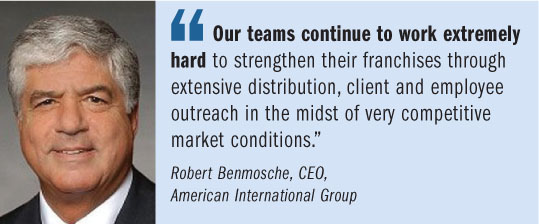Property and casualty results at American International Group deteriorated slightly in a competitive market, while overall the company reported a second-quarter net loss of $2.7 billion, primarily due to a $3.3 billion goodwill impairment charge on the sale of a life subsidiary.
Robert Benmosche, the New York-based insurer's chief executive officer, said in recorded comments on AIG's website that the impairment was taken to write off the goodwill that had been allocated to life unit ALICO, which is being sold to MetLife for $15.5 billion. Mr. Benmosche said he expects that deal to close later this year.
(AIG also announced last week that it will sell its majority interest in its consumer lending business, American General Finance, and take a pre-tax loss of $1.9 billion in the third quarter from the transaction. See accompanying story for more details.)
 The $3.3 billion impairment charge in the second quarter was part of $3.4 billion in net losses from discontinued operations.
The $3.3 billion impairment charge in the second quarter was part of $3.4 billion in net losses from discontinued operations.
The $2.7 billion quarterly net loss compares to 2009 second-quarter net income of $1.8 billion.
Mr. Benmosche said adjusted net income for the quarter–which excludes the impairment and other gains and losses on sales of businesses, as well as excluding $564 million in net realized capital losses–was $1.3 billion. Adjusted net income in the 2009 second quarter was $1.1 billion.
For its Chartis property and casualty operations, the company said 2010 operating income was $955 million, down slightly from $1 billion in 2009's second quarter. Chartis incurred around $287 million in catastrophe losses, due mostly to floods in the Southeastern U.S., Hurricane Alex, U.S. hailstorms, and the Deepwater Horizon explosion and subsequent oil spill.
AIG said Deepwater Horizon losses are $23 million, and the company believes its carried loss reserves are adequate to cover estimated losses.
Chartis' 2010 second-quarter combined ratio was 102, up from 98.2 a year ago. Excluding catastrophes, the combined ratio was 98.3–essentially flat compared to 98.2 a year ago.
Worldwide net premiums written for Chartis declined 1.6 percent to $7.8 billion in the quarter, due to “risk management initiatives and pricing discipline in lines where rates are unsatisfactory,” the company said in its earnings release.
For the first half, net premiums written were down 1.4 percent to $15.4 billion.
“Chartis is actively pursuing risk management initiatives to reduce its aggregate exposure in certain property and casualty lines of business,” the company noted. “While Chartis continues to see improved premium and account retention, new business submissions, and a relatively stable rate environment, net premium writings continue to be adversely affected by a weak economic environment.”
AIG's Financial Products unit–which the company is in the process of winding down–reported a 2010 second-quarter operating loss of $132 million, which was flat compared to a year ago.
The unit's dealings in credit default swaps was at the center of the company's near collapse–which led to the federal government making $182.3 billion available via the Troubled Asset Relief Program to bail out the company.
Mr. Benmosche said the unit has done a good job of winding down its operations “amid all the noise” about compensation and risk exposures. “Let's remember where we were in September 2008,” he said, noting that the unit's $2 trillion in exposures at that time has been reduced by 70 percent.
For the first six months of 2010, AIG reported a net loss of $799 million, compared to a 2009 first-half loss of $2.5 billion.
Overall, Mr. Benmosche said AIG's insurance businesses are profitable, client retention has stabilized, and employee turnover is “well within the norm.”
He said work at the company to repay the government and become independent again “remains immense, but we are starting to see the light at the end of the tunnel.”
The company has commenced discussions, he said, regarding terms for an AIG exit from 80 percent control by the government.
Mr. Benmosche added that the company expects to make “meaningful progress” in 2010 toward repayment to the Federal Reserve Bank of New York.
New York Fed borrowing stands at $20.5 billion, plus accrued interest fees of $6 billion, the company said.
“Importantly, operating earnings at our continuing insurance operations have remained solid and stable,” he added. “Our teams continue to work extremely hard to strengthen their franchises through extensive distribution, client and employee outreach in the midst of very competitive market conditions.”
Mr. Benmosche said the company's “focus is on continuing to strengthen our core operations by maintaining or improving their financial strength, improving efficiency and transparency, and better balancing risk and return.”
On the life side, SunAmerica Financial Group reported 2010 second-quarter operating income of $1.1 billion, up from $254 million in the previous year's second quarter.
The company rejected Prudential's proposed revised terms to acquire its American International Assurance Company (AIA), and AIG said it will now conduct an initial public offering of AIA.
Want to continue reading?
Become a Free PropertyCasualty360 Digital Reader
Your access to unlimited PropertyCasualty360 content isn’t changing.
Once you are an ALM digital member, you’ll receive:
- Breaking insurance news and analysis, on-site and via our newsletters and custom alerts
- Weekly Insurance Speak podcast featuring exclusive interviews with industry leaders
- Educational webcasts, white papers, and ebooks from industry thought leaders
- Critical converage of the employee benefits and financial advisory markets on our other ALM sites, BenefitsPRO and ThinkAdvisor
Already have an account? Sign In Now
© 2025 ALM Global, LLC, All Rights Reserved. Request academic re-use from www.copyright.com. All other uses, submit a request to [email protected]. For more information visit Asset & Logo Licensing.








